Know what the more effective marketing strategies It should be the first step of any company or business on the Internet.
You would be surprised by the number of companies that start an adventure without any kind of roadmap.
Without a plan that guides them with all the actions they have to carry out to achieve goals.
It is no coincidence that the 80% of businesses fail before 3 years.
Therefore, in this guide I am going to tell you the 32 types of marketing strategies for companiesI know that you should know, and above all apply.
To do this, I will also show you several examples of marketing strategies.
And if you have any questions, see you in the comments.
What is a marketing strategy?
Surely many times you have thought about tactics and actions but you have never really stopped to think about what a marketing strategy is and why it is so important.
In a very summarized way, a marketing strategy is a set of actions that we are going to carry out to achieve the business objectives of the company and thus achieve the goal.
Perhaps with this graphic that summarizes the essential steps when it comes to elaborar un plan de digital marketing it is much clearer to you.

<>
Quickly explained, we could divide the process into four stages:
1) Business model of the project.
Any type of action, or tactic that is carried out must be related to the business model of the company.
A very common mistake that I see in a large number of companies is to think about publications, emails, articles, etc. without them having any relation to the project's revenue streams.
It seems obvious, but when it comes to reality, it is not so obvious.
2) Analysis stage
Once it is clear where you want to go, a marketing audit is carried out where we will analyze our project and that of the competition.
Then we will have to do the SWOT analysis de una empresa and analyze what factors we can exploit, but also be aware of other elements.
Next we will have to define our target audiences and quantify how many means (monetary, physical and personal) we have to later choose which ones are going to be our communication channels.
3) Strategic definition
Once we are clear about all these elements, what we will do is determine the objectives.
Depending on what we want to achieve, we must define the most appropriate strategies to help us achieve them.
Subsequently, it will be necessary to specify the tactics and define the KPI de marketing that we have will help us measure whether we are achieving the objectives.
4) Analysis
And based on that analysis we will establish corrective measures (in case they are necessary and the objectives have not been achieved).
As you have seen, it is a strategic process that cannot be understood without knowing the context of all the elements because they are all related to each other and are affected by each other.
35 Types of Marketing Strategies for Most Effective Companies
Depending on the competitive position of your business, the resources you have and your objectives, there will be a series of strategies that are more effective than others.
But, remember that in the end, they must all be integrated under the same objective.
Personally, if I had to highlight the most important ones, I would tell you that the best marketing strategies for companies We can divide them into two large groups:
- Strategic marketing strategies.
- Digital Marketing Strategies
So we are going to get down to work and we are going to see one and with different examples so that everything can be clear to you.
Best Strategic Marketing Strategies
The decisions of the company at a strategic level are essential for the survival of the same, they can affect the entire business.
It can influence from the price, forms of expansion, growth, reduction of investments, etc. so we are going to see the main strategic decisions that you should take into account.
1) Estrategias de Marketing Mix: Las 4 Ps
The famous 4 P's (or Marketing Mix) are a classic of marketing but they are being given less and less importance.
The reason? We focus so much on digital that sometimes we forget the most basic and essential aspects.
We spend the day thinking about cómo hacer publicidad en Facebook, cómo posicionar nuestra página Web, etc. que a veces nos olvidamos de las decisiones más estratégicas a nivel de negocio.
To do a marketing mix, the first thing we will have to define are the 4 P's:
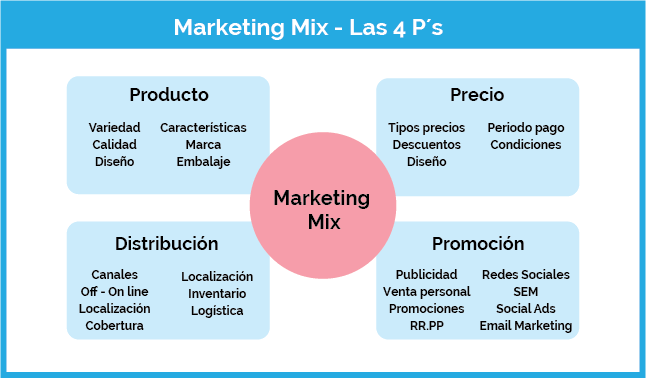
Let's see examples of each of these variables of the marketing mix.
 A) Product strategy
A) Product strategy
By product we understand what the company is going to market in a certain market to solve certain problems (needs).
At this point, it will be necessary to finish all the variables that can affect your marketing such as:
- The brand.
- The Packaging.
- The tags.
- The guarantee.
- Delivery.
- The credit.
- Safety.
- The geographical origin.
- The company's own prestige.
- After-sales service.
- Its own characteristics.
All these variables and characteristics must be clear before launching it on the market.
 B) Pricing Strategy
B) Pricing Strategy
The pricing strategy will consist of defining how much each of the products and / or services that we launch on the market will cost.
That is, we will have to determine the amount of money that a person could pay.
Here we must take into account the 3 C's of marketing that are: Customers, Costs and Competition.
And based on these three variables we will have different pricing methods.
- Cost-based pricing methods
- Competitor-based pricing methods
- Demand-based pricing methods
 C) Distribution strategies
C) Distribution strategies
The next step will be to determine what is the company's distribution channel.
In short, what other companies are going to intervene from when manufacturing begins until it is marketed.
It must also be taken into account if the sale is only going to be through a physical store or if otherwise it is also going to be combined with an online store or eCommerce.
Depending on how many organizations are going to intervene, we will have different distribution channels.
Other things that you should take into account when designing your distribution channel are:
 D) Promotion strategies
D) Promotion strategies
They help us determine how we are going to communicate to our potentials that we are the best possible alternative to solve their problems.
There are different types of communication for example:
- Advertising.
- Sales promotion.
- Public relations.
- Sponsorship.
- The fairs.
- Guerrilla marketing.
- The media such as TV, Radio, Press.
- Email marketing.
- Etc.
Try to combine online with offline and carries out integrated communication.
That is, whatever channel you use, try to always transmit the same message (adapting it to each medium).
2) Target audience segmentation strategies
Market segmentation and the choice of the target audience is one of the main aspects that we have to take into account when designing marketing strategies.
We can distinguish between 4 main types:
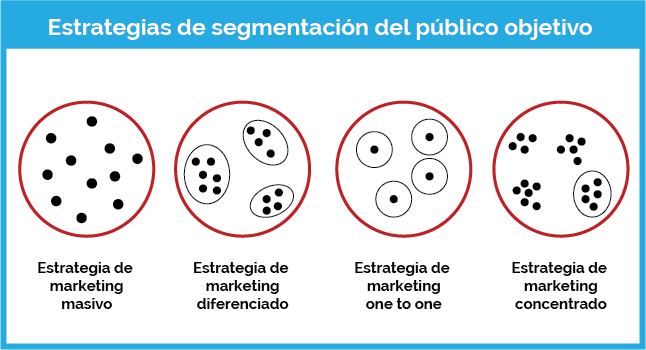
 A) Undifferentiated or mass marketing strategy
A) Undifferentiated or mass marketing strategy
This type of target audience strategy consists of attacking with the same product to the entire market.
That is to say, we do not do any segmentationInstead, we address the entire market with a single offer.
 B) Differentiated or segmented marketing strategy
B) Differentiated or segmented marketing strategy
Contrary to the previous case, in the differentiated segmentation strategy we must select two or more segments and carry out a different marketing strategy for each of the segments.
In this case, the company will be able to adapt much better to the needs of each of its segments and offer different commercial offers.
The drawback with respect to the previous case is that it has higher costs.
 C) Micro segmentation or micro marketing strategies
C) Micro segmentation or micro marketing strategies
This type is similar to the previous one but taken more to the extreme.
Here we consider each potential client as a single segment and therefore we try to adapt our offer to each person.
We can distinguish between two types of segmentation:
- Local Marketing: The objective is to try to adapt the commercial offer to the characteristics of local consumers and thereby differentiate itself from the competition.
- Individual or one-to-one marketing: consists of customizing the product to the greatest possible detail.
 D) Concentrated or niche marketing strategy
D) Concentrated or niche marketing strategy
With the niche strategy what we do is segment consumers but we are only going to choose a single segment of all.
When the segment we have selected is not the majority, then it will be a niche strategy.
The downside is that we are going to focus all of our marketing efforts on a single niche.
What if that segment disappeared or your needs changed?
3) Estrategias de positioning de marca
You should already know the target audience to target and how to do it.
The next step is to determine the brand positioning strategy that you are going to follow.
Note:
Brand positioning after all is what place our product occupies in the mind of the consumer.
That is, how do potential customers view our solution in relation to other competitors?
This is very important, because for example, if we want to position ourselves by quality or by prices, we must adapt all actions to that objective.
Otherwise, we could be facing a brand positioning problem.
 A) General positioning strategies
A) General positioning strategies
If we want to position our brand, the first thing we will have to do is specify the most general aspects, which can be:
- Based on the competition
- Consumer-based
- Based on social responsibility
 B) Specific positioning strategies
B) Specific positioning strategies
While among the most specific are:
- Basado en el attribute.
- Based on profit.
- For a specific occasion of use or application.
- Based on the class of users.
- Related to other products of the same class.
- The brand is endorsed.
- Based on the shopping or consumer experience.
4) Growth strategies of a company
Once the company is in the operating sector, it must decide how it wants to grow.
Here we will be talking about an old acquaintance from the business world such as the Ansoff Growth Matrix, which has two main factors as its main axes:
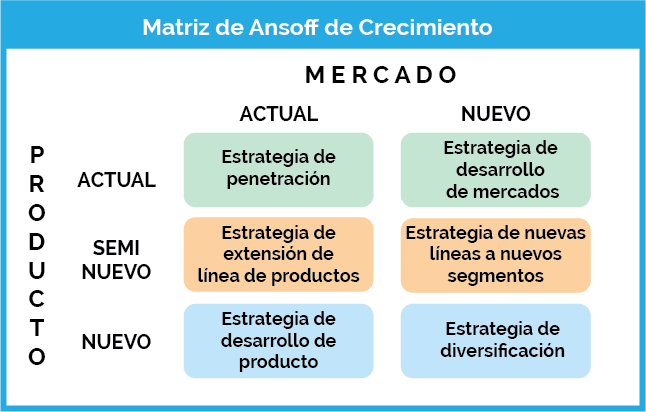
 A) Penetration strategies
A) Penetration strategies
Market penetration consists of grow with the same product and in the current market.
It basically consists of increase market share either by:
- Marketing campaings.
- Reduce prices.
- Make promotions.
Whatever you do, the end result should translate into an increase in customers.
An example could be a telephone company that wants to increase its market share at the expense of its competition.
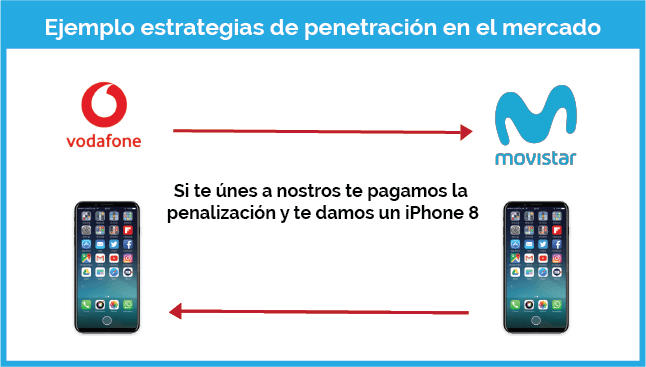
This example I have put a bit exaggerated, but surely that way you understand it better.
Others resources to increase market share they could be:
- Increase the frequency with which it is consumed.
- Increase your average consumption.
- Give it a new use.
 B) Market development strategy
B) Market development strategy
Consists in offer your current products but to new markets.
That is, I am selling to a new customer segment or I am heading to a new geographic market.
It is a good way to get a greater return of investment because you don't have to develop a new one.
What you have to do are marketing campaigns focused on new markets.
A market development example it could be what Nintendo has done with a 3DS console.
Initially, he focused on a younger audience and later directed his marketing actions to an older audience.
 C) Product development strategy
C) Product development strategy
It involves offering a new product to current markets.
We could do it in the following ways:
- Expanding the line.
- Creating new ones.
- Expanding the portfolio.
- Adding new features to the current one.
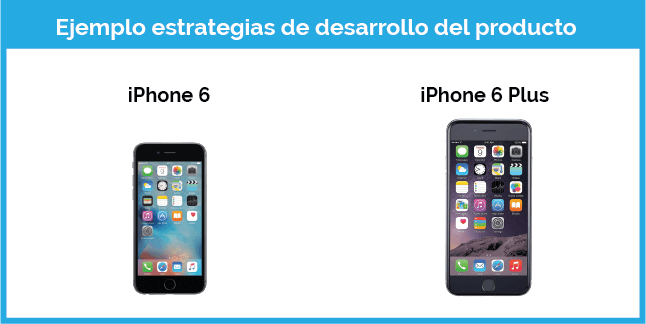
A clear example would be the case of the iPhone 6 and its extension to the iPhone 6 Plus.
The market is the same, but the iPhone is "new"
 D) Diversification strategy
D) Diversification strategy
The diversification strategy is the most radical of all because involves creating a new product and directing it to new markets.
The good thing is that you reduce the overall risk of the company by not depending on the same product or the same market.
The problem is that it is the riskiest of all and the one that will entail the highest costs.
You also have to know that they exist different types of diversification:
- Related diversification.
- Unrelated diversification.

An example could be Yamaha, which has both pianos and motorcycles.
In this it would be almost unrelated, because the activity of one is not related to that of the other.
5) Divestment strategies
Many times to grow you do not have to invest more, quite the opposite.
Sometimes the best marketing strategy is withdraw our investment from those products and / or services that are no longer giving us a positive return on investment.

When deciding which ones we want to eliminate we will have to analyze a series of factors or parameters such as:
- Sales criteria: What is the evolution of sales? What percentage does it mean with respect to our total sales?
- Profitability criteria: He ROI o el beneficio.
- Market criteria: market share and its evolution.
- Operational criteria: after-sales services or stock level.
These are the criteria that we will have to analyze before making any decision.
Based on this, we can distinguish between:
- E. of elimination: It consists of taking the product that the company is marketing off the market.
- Harvest season: exit the market but trying to get the money back from all previous investments.
- E. of support: We do not invest more in that product, but we do not reduce the investment either.
6) Competitive or corporate marketing strategies
Finally, at the strategic marketing level, we would have the corporate strategies that are based on deciding what the competitive situation of the company will be and what role it will want to have in the market.
Here we are talking about Kotler's four competitive strategies based on making decisions based on the market share that the company has and the situation of the competition.
 A) Leader strategy
A) Leader strategy
The industry leader is the company with the largest market share Therefore, all the marketing strategies you do will be focused on reinforcing your competitive situation and increasing your share.
At the same time, you will also have to take actions not only to get more market share, but also to maintain your situation, that is, to defend market share.
 B) Challenger strategy
B) Challenger strategy
It is carried out by those companies that want to unseat the leader from his privileged situation and therefore they design all kinds of tactics to achieve it.
They can be distinguished between frontal, lateral, rodeo and guerrilla attacks.
An example could be the battle between Coca-Cola and Pepsi to oust each other.
 C) Estrategia de follower
C) Estrategia de follower
It is adopted by those companies that are very comfortable with their current competitive position and they think that attacking the leader would harm them more than benefit them.
The tactics that they usually carry out are practically linked to those that other companies in the sector do.
In other words, they do not carry out any kind of radical strategy that could threaten the rest.
 Estrategia de especialista en un nicho de mercado
Estrategia de especialista en un nicho de mercado
They carry it out companies that identify that in certain market niches there are customer segments that do not have their needs covered.
Large companies tend to go unnoticed by this niche and do not direct their actions to such a specific segment, so it is a way to differentiate themselves because customers can associate your company with their values.
A example of is Moritz beer which aims to identify itself geographically with Catalonia and only sells beers in this territory, this makes its consumers much more involved with this brand.
Best Digital Marketing Strategies for Business
There are different types, but the best known are the ones that I am going to mention below.
The choice of one or the other will depend on what you want to achieve, the resources and where the target audience of the company is.
Eso sí, recuerda que para poder medirlo todo tienes que tener instalado Google analytics Yes or yes.
 1) SEO
1) SEO
El SEO es uno de los canales más potentes para atraer traffic cualificado.
Brands have realized that posicionar una página web en las primeras posiciones de Google it is essential to get a constant flow of visits.
But search engine optimization is not a bed of roses.
It is like a marathon race, it takes many months to prepare and you need time to see the results.
The same happens here, in fact, depending on the cases, it is recommended between a minimum period of 6 months to start seeing green shoots.
 2) Email marketing
2) Email marketing
The email marketing It is one of the channels with the highest return on investment.
There are many persons que han dado por «muerto» al email marketing, pero se equivocan.
This channel is more alive than ever, the only thing that has died is the old way of doing email marketing.
Now we have to do it in a much more personalized way and segmenting users to be able to offer them what they need and not impact them with thousands of campaigns that do not interest them.
 3) Social media
3) Social media
¿Facebook, Instagram, Youtube, Twitter, Tic Tok?
There are millions of users using social networks around the world.
If our target audience is in it, we should be there too.
In addition, if we combine them together with advertising on social networks, the combination can be really effective.
Of course, remember that it is essential to have optimized social profiles and a well-planned editorial calendar at least.
 4) Advertising on Social Networks
4) Advertising on Social Networks
One of the most powerful channels to get leads at a really cheap price is advertising on social networks.
Facebook and Instagram are the two social networks where we invest a greater economic amount.
We use it so much pTo generate community, attract subscribers and then sell tickets, courses or any other type of training.
Pero si tu negocio es B2B, también puedes probar con la publicidad en LinkedIn.
Además, para campañas de branding or remarketing, también puede funcionar realmente bien la publicidad en YouTube.
 5) Google Ads
5) Google Ads
Advertising on Google is advertising that appears in the top (and sometimes bottom) results when you perform a specific search on Google.
Google Ads continues to be a channel to increase conversions for a very important company.
The main advantage is that we can appear in the first positions practically immediately, while in SEO it is long term.
 6) Content marketing or Content Marketing
6) Content marketing or Content Marketing
AND Blog es un arma muy potente para conseguir atraer nuevos clientes, convertirlos en clientes y fidelizarlos.
Think that to sell online, trust is an essential element.
Through content, we can increase it and above all, position ourselves as a benchmark within a sector.
Para ello, no te olvides de que crear contents de calidad no es una opción, sino una obligación.
 7) Affiliation
7) Affiliation
Muchas empresas y sobre todo emprendedores viven de la afiliación que consiste en recibir una comisión si te compran a través de un link from affiliate.
It usually occurs among entrepreneurs who sell infoproducts their own or other people's and to increase their turnover, they recommend other people's products.
 8) Webinars
8) Webinars
Webinars are one of the most powerful business marketing tools out there today.
They are the transformation of the typical workshops that were previously held in person, but in an online version.
A través de diferentes Masterclass vía streaming o en diferido a través de las cuáles puedes aumentar la comunidad, aumentar la base de datos e incrementar las ventas.
In combination with social ads and email marketing it is a really powerful tool.
 9) Video marketing
9) Video marketing
Video has become the preferred type of format for many people to consume content.
More and more businesses are integrating video into their day to day.
The problem is also that many companies understand that video marketing is only publishing videos and that's it.
And they are wrong, because like for example in a blog you have to analyze what terms people are looking for in order to later be able to develop that content, the same thing happens with video.
In short, it is essential to know what content people want to consume.
 10) Marketing with influencers
10) Marketing with influencers
Influencer marketing is the known referral marketing but amplified.
One of the main sources we trust when buying is our friends or family.
We heed their recommendations and we let ourselves be guided by them.
And this basically consists of hiring people who have a certain prestige within their sector to recommend the company's products.
Other marketing strategies for SMEs
 1) Street marketing
1) Street marketing
It is based on carrying out actions in public spaces with the ultimate goal of making the campaigns go viral.
It has been carried out in the streets themselves as well as in shopping centers.
For this type of campaign to be viralized, a series of factors must occur, including that there is a minimum of people who are capable of recording the content and disseminating it on social networks.
 2) Experience Marketing
2) Experience Marketing
The experience marketing It consists of connecting with the client through feelings, of awakening emotions.
Es otra técnica que también es cada vez más utilizada por los negocios para diferenciarse de la competencia y porque muchas veces, se consigue lograr la ansiada virality.
What characterizes emotional marketing is that instead of paying attention to the elements of the product such as its characteristics, packaging, etc. focuses on what the customer can experience with them.
 3) Stories Marketing
3) Stories Marketing
Also known as the Storytelling it is a technique increasingly used by companies.
In short, it could be said that it consists of selling by telling stories. In other words, the goal is to keep our consumers hooked throughout the ad to try to arouse their emotions.
In the current scenario, in which each person receives thousands and thousands of advertising impacts per day, this has become a new marketing tool to connect with our audience in a less aggressive way.
 4) Event Marketing and Sponsorships
4) Event Marketing and Sponsorships
Events or workshops are a really effective type of resource when it comes to increasing the authority and sales of a business.
We at the Marketing and Web School do them constantly (both in person and online).
For example, once a year we organize a face-to-face Congress in Valencia whose objective is to attract students for the Master.
Simultaneously, we also carry out face-to-face workshops with the same objective.
Y si no te animas a crear tu propio event, siempre puedes formar parte de uno a través del patrocinio.
In this way, you do not run the risk of the investment.
You only make a payment to be able to have a series of privileges.

What is the best marketing strategy for a business?
Perhaps this is the question you are asking yourself after seeing so many types.
I'm sorry to tell you that the answer is it depends.
When choosing one or the other, there are different aspects that must be taken into account, such as:
- The competitive situation.
- The resources.
- Technical knowledge.
- The purchase process in which the consumer is.
- Etc.
What I recommend is that you combine the offline part with the online one, in this way you will get better results.
And now yes, it is your turn. If you have any questions, see you in the comments.

![35 Tipos de Estrategias de Marketing más efectivas [Ejemplos]](https://rmarketingdigital.com/wp-content/uploads/2020/11/mejores-estrategias-de-marketing-empresas-02-1-9467828.png)
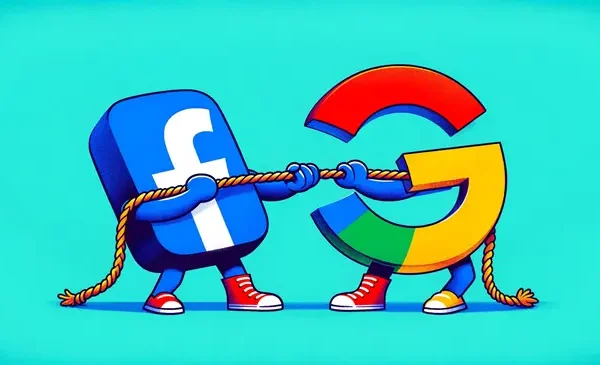

![40 Best Applications for Instagram in 2020 [Essential Tools]](https://rmarketingdigital.com/wp-content/uploads/2020/11/mejores-aplicaciones-para-instagram-1-9698449-600x322.png)


